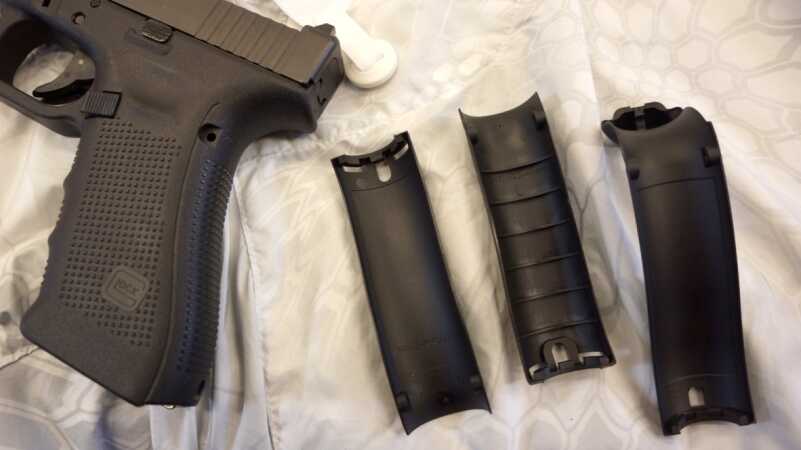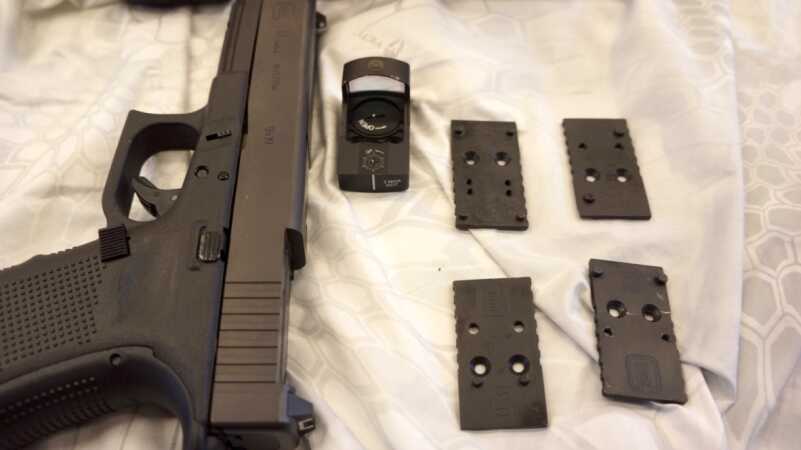To learn more, visit https://us.glock.com/mos/.
To buy a Glock 17 MOS of GunsAmerica.com, click this link: https://www.gunsamerica.com/Search.aspx?T=Glock%2017%20MOS.
This week at GunsAmerica, I got my grubby little paws on a Glock 17 MOS. I am a long-time member of the Glock fan club, but this was the first time I have reviewed anything from the 4th Gen of Glock. I liked my 3rd Gens so well, I never even considered buying anything else.

The key to the MOS system is the fact that you can attach red dot optics to your pistol, right from the factory.
Gen4 was introduced in 2010, with the MOS models following a few years later. This was the answer to a market suddenly floating in polymer frame pistols, many of which had options not available on the Glock. This represented the first major design change since the Gen3 upgrades in the 1990s.
SPECS
- Chambering: 9mm
- Barrel: 4.48 inches
- OA Length: 7.95 inches
- Weight: 25.06 oz
- Frame: polymer
- Grips: polymer
- Sights: 3 dot, plastic
- Finish: Matte black
- Capacity: 17+1
- MSRP: $599.00
First up was the addition of interchangeable backstraps, an extremely common feature today. Hard to believe that 15 years ago, this was basically unheard of. The Gen4 frames also finally allowed a left or right side magazine release, which has become very important for new pistols. The Devil handed have spoken. If your magazine release isn’t reversible, you just wrote off 10+% of the population as customers. The new magazine release is also much larger in surface area that the older style, which has had a positive reception. The last major change was the redesign of the recoil system, a switch to a dual spring style recoil spring. This was applied to all Gen4 pistols, though the largest gain was seen in punchier calibers like .40 S&W and 10mm.
What Does It Mean?
What’s the difference then between Gen4 and Gen4 MOS pistols? Also, what does MOS mean? Glad you asked. MOS stands for Modular Optics System, which in five dollar words means you can put a red dot sight on it. The slide is cut out from the factory for the ability to low mount a variety of electronic sights via adaptor plates. The Glock brand is quite supportive of the industry; I haven’t found one sight that isn’t usable. Glock also led the charge on this innovation, with other manufacturers now catching up—unless you count custom race guns, which I don’t. The price point for this feature is also quite low; there is only a difference of $60 MSRP from the Gen4 to the Gen4 MOS.
Do You Need It?
This is where the wicket gets sticky, and some consumers start to cry foul. Plenty of people are not going to pay another $600 for a red dot, and take offense that you even suggest that is a possibility. Please, bear with me a moment while I explain why I think this absolutely a value-added proposition.
You might not want a red dot right now, nor might you be able to afford it. Totally get that. But that might not always be the case. Much like HDTVs or heated seats in a car, technology gets cheaper with time. When HD LED/Plasma screen technology first appeared on the market, it was priced only for the super rich. Within five years, however, it was affordable for most consumers. And now, 15 years later, I dare you to try and find a non-HD model new on the shelf anywhere. The smallest $200 Black Friday special at your local box store is HD, and it comes with HDMI ports.
Currently, red dot sights range from very expensive, down to as low as $250 and less for a Burris Fast Fire III (here are some on GunsAmerica.com for sale). Less expensive options like the Burris lack some of the features found in other models, but all of them nowadays tend to be tough. There are some growing pains happening right now with red dots, like lack of a movement sensor to turn them on. Kind of a big deal in a carry gun, unless you remember to pull it out and hit a button every three hours. But they get better every year. The point is, red dots are getting more suitable for duty use, and cheaper, by the minute. Much the way electronic sights changed the game with rifles, a similar renaissance is happening with pistols. We are at a tipping point with them, and my guess is that within five years it will be considered normal to carry one.

Part of the Gen4 enhancement package is a set of swappable back straps for customizing the pistol to your needs.
What You Get
So, what is the value added? An MOS model makes your pistol adaptable. Very few of us start our journey with firearms being flush with disposable cash. I saved my airborne pay for six months to buy my first pistol, and that was hard on a corporal’s salary. In this case, the extra $60 for the MOS keeps your pistol relevant longer. It works out of the box, just like any other Glock. Even comes with the same plastic sights as the other models installed. It takes nothing away from the gun; in fact the gun works flawlessly even if you lose the plate cover and fill the holes with mud. I tried it, so we both know. If you don’t have the coins for a red dot today, this at least keeps the option open. On the regular, I pay over $100 just to replace the iron sights on my guns. $200 if you want night sights. Threaded barrels, if you go that road later, will cost $200-$300, and a suppressor close to $1,000. $60 doesn’t seem like a bad investment compared to that.
Why might you want a red dot, now or in the future? There are a variety of reasons really. One factor to consider is aging eyes. As you get older, that front sight is going to be harder and harder to see. Red dots fix that problem for you. If you plan to end up with suppressors, red dots are a lot easier to use than suppressor height iron sights. One thing that really surprised me in this review was the speed component. I have used a pistol optic before, but I had never put it on the clock against iron sights. A red dot has traditionally felt slower to employ to me, but the timer showed that to be largely false. And that was with limited training time. Optics-mounted pistols may actually be faster to use, it will just take a longer time to know for sure. One thing is for certain, it is easier to be accurate with a red dot. The Gen4 MOS beat the pants off of my Glock 34 with irons in the long range accuracy test, and the irons gun had a significantly better trigger. I am not a bullseye ninja by any stretch of the imagination, but the MOS got me hits to 125 meters on a B/C zone piece of steel. That is a pretty far reach for a mortal using 9mm.
So, there it is. Is an MOS right for you? That is for you to decide, but you know where I stand on the issue.
To learn more, visit https://us.glock.com/mos/.
To buy a Glock 17 MOS of GunsAmerica.com, click this link: https://www.gunsamerica.com/Search.aspx?T=Glock%2017%20MOS.





Bravo! Another useless Glock hating article. You folks at GunsAmerica are on a roll. Please, if you are going to bash the product, don’t waste our time. I like to read objective reviews, not childish ones.
Did you read the article?
It’s clearly not an anti Glock article.
Thanks again for your time to review and I and we appreciate it. I have been considering red dot and wish I could shoot it before I invest. I have a G17 and a 19, can shoot the 17 faster and more accurate. Wish we lived closer to you so we can try out all the cool guns you get! Oh, you need a heater for your little shop? Thanks again!!!
Good to see the major manufacturers starting to do this. Been shooting red dots on my pistols for a few years now but had to have my slides milled. Nice to see them out of the box. If you have a red dot mounted on your rifle you really should consider putting one on your pistol for the same reasons. If you mount a red dot be prepared to swap out for suppressor height sights too.
Good write-up! Helpful and entertaining. Well done sir.